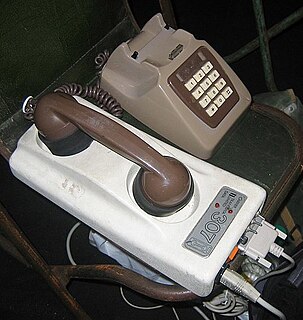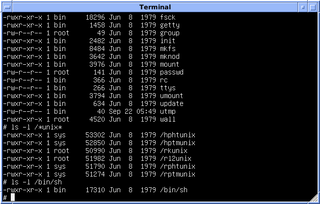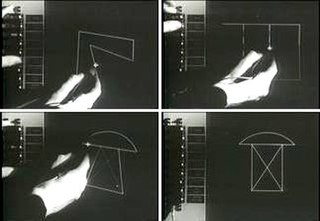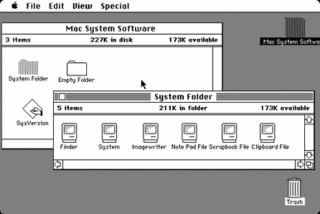ProTERM is a terminal emulator and modem program for the Apple II [1] [2] and Macintosh lines of personal computers, published by Intrec Software. Most popular in the late 1980s and 1990s, it was most commonly used for calling bulletin board systems (BBSes) via a computer's modem, experienced users could also Telnet into Unix server and shell account thereon and FTP and tunneling to various destinations therefrom, and once logged into a Unix shell account, other forms of telecom all across the pre-Web Internet; via VT100 terminal emulator or ANSI art, this later ushered in Graphics to the scene.

A terminal emulator, terminal application, or term, is a computer program that emulates a video terminal within some other display architecture. Though typically synonymous with a shell or text terminal, the term terminal covers all remote terminals, including graphical interfaces. A terminal emulator inside a graphical user interface is often called a terminal window.

A modem is a hardware device that converts data into a format suitable for a transmission medium so that it can be transmitted from computer to computer. A modem modulates one or more carrier wave signals to encode digital information for transmission and demodulates signals to decode the transmitted information. The goal is to produce a signal that can be transmitted easily and decoded reliably to reproduce the original digital data. Modems can be used with almost any means of transmitting analog signals from light-emitting diodes to radio. A common type of modem is one that turns the digital data of a computer into modulated electrical signal for transmission over telephone lines and demodulated by another modem at the receiver side to recover the digital data.

A personal computer (PC) is a multi-purpose computer whose size, capabilities, and price make it feasible for individual use. Personal computers are intended to be operated directly by an end user, rather than by a computer expert or technician. Unlike large costly minicomputer and mainframes, time-sharing by many people at the same time is not used with personal computers.
The macro Language automated a lot of this process and the ProTERM user could code macros to log in and perform Unix functions in Bash or Bourne shell making this a very powerful terminal emulator, capable of manipulating mainframes and "hacking" into the heart of the internet at low and high levels.

Bash is a Unix shell and command language written by Brian Fox for the GNU Project as a free software replacement for the Bourne shell. First released in 1989, it has been used widely as the default login shell for most Linux distributions and Apple's macOS Mojave and earlier versions. A version is also available for Windows 10. It is also the default user shell in Solaris 11.

The Bourne shell (sh) is a shell, or command-line interpreter, for computer operating systems.
ProTERM was rich in features such as an extensive "scrollback" buffer limited only by the computer's memory, an optional mouse-based interface in the Apple II version (standard on the Mac), an easy-to-use and very powerful text editor, auto learning macros, and a variety of terminal emulations such as VT100, ANSI and the powerful but proprietary "ProTERM Special Emulation" (also referred to as: PSE or PTSE) which used Apple's semi graphical MouseText character set. Supported file transfer protocols ranged from Kermit and Xmodem to Ymodem (Batch, 4K and G) and Zmodem (Batch Selections).

A computer mouse, often simply referred to as a mouse, is a hand-held pointing device that detects two-dimensional motion relative to a surface. This motion is typically translated into the motion of a pointer on a display, which allows a smooth control of the graphical user interface. The first public demonstration of a mouse controlling a computer system was in 1968. Originally wired to a computer, many modern mice are cordless, relying on short-range radio communication with the connected system. Mice originally used a ball rolling on a surface to detect motion, but modern mice often have optical sensors that have no moving parts. In addition to moving a cursor, computer mice have one or more buttons to allow operations such as selection of a menu item on a display. Mice often also feature other elements, such as touch surfaces and "wheels", which enable additional control and dimensional input.

A text editor is a type of computer program that edits plain text. Such programs are sometimes known as "notepad" software, following the naming of Microsoft Notepad. Text editors are provided with operating systems and software development packages, and can be used to change files such as configuration files, documentation files and programming language source code.

A macro in computer science is a rule or pattern that specifies how a certain input sequence should be mapped to a replacement output sequence according to a defined procedure. The mapping process that instantiates (transforms) a macro use into a specific sequence is known as macro expansion. A facility for writing macros may be provided as part of a software application or as a part of a programming language. In the former case, macros are used to make tasks using the application less repetitive. In the latter case, they are a tool that allows a programmer to enable code reuse or even to design domain-specific languages.
One feature of ProTERM Mac was the C-like scripting or macro language embedded inside ProTERM, allowing users to code and run ProTERM automatically. ProTERM could also be programmed to log in and execute command-line interface commands on the host machine, effectively controlling it remotely.

A command-line interface (CLI) is a means of interacting with a computer program where the user issues commands to the program in the form of successive lines of text. The program which handles the interface is called a command-line interpreter or command-line processor, or shell.
The latest published versions of ProTERM were v3.1 for the Apple II and v1.5 for the Macintosh. On January 3, 2009, the most recent Apple II version, 3.1, was relicensed as freeware [3] and is now available for download.
Software relicensing is applied in open-source software development when software licenses of software modules are incompatible and are required to be compatible for a greater combined work. Licenses applied to software as copyrightable works, in source code as binary form, can contain contradictory clauses. This requirements can make it impossible to combine source code or content of several software works to create a new combined one.
Freeware is software, most often proprietary, that is distributed at no monetary cost to the end user. There is no agreed-upon set of rights, license, or EULA that defines freeware unambiguously; every publisher defines its own rules for the freeware it offers. For instance, modification, redistribution by third parties, and reverse engineering without the author's permission are permitted by some publishers but prohibited by others. Unlike with free and open-source software, which are also often distributed free of charge, the source code for freeware is typically not made available. Freeware may be intended to benefit its producer by, for example, encouraging sales of a more capable version, as in the freemium and shareware business models.










